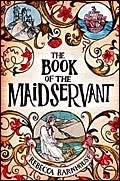The Book of the Maidservant is about a girl in fifteenth-century England who went on a pilgrimage to Rome with Dame Margery Kempe, one of history's more difficult employers. Dame Kempe felt a religious calling which she expressed by bursting into loud weeping, harshly criticizing others, and insisting God spoke to her personally. Though we don't know her maidservant's name, she really existed.
Fourteen-year-old Johanna, responsible for hauling water, emptying chamber pots, and getting the fires started in the morning, comments, "my mistress likes to be warm and toasty while she shares Our Lady's pain." On pilgrimage, Johanna faces separation from her friends and family, a frightening ship voyage, a cruel fellow pilgrim, more work than she ever imagined she could handle, and constant slights. "My mistress wears a broad-brimmed leather pilgrim's hat that ... keeps the rain off her head. I am not a pilgrim, just a pilgrim's maidservant, so I get no hat." She also meets people like John Mouse, a wonderfully kind and attractive young clerk. Crossing the Alps as winter approaches is a huge challenge. More terrifying, though, is when Dame Kempe abandons Johanna to make her way alone in a city where she doesn't understand the language.
Johanna's world is Roman Catholic, and when her triumphs and insights come at the end of the novel, they come in a form appropriate to her world. But this is not a preachy novel. Its spirit is universal and can be appreciated by readers of any religious faith or none. Both young readers and adults who can appreciate the fun this novel pokes at hyper-religious hypocrites will enjoy it. (2009; 232 pages, including an author's note about the history behind the story)




